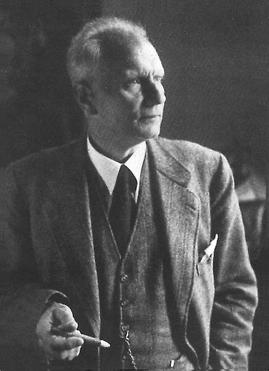Walther Gerlach facts for kids
Quick facts for kids
Walther Gerlach
|
|
|---|---|
 |
|
| Born | 1 August 1889 Biebrich, Hessen-Nassau, German Empire
|
| Died | 10 August 1979 (aged 90) |
| Nationality | German |
| Alma mater | Eberhard Karls University of Tübingen |
| Known for | Stern–Gerlach experiment |
| Scientific career | |
| Fields | Experimental Physics |
| Institutions | Johann Wolfgang Goethe University of Frankfurt am Main Eberhard Karls University of Tübingen |
| Academic advisors | Friedrich Paschen |
| Doctoral students | Gertrude Scharff Goldhaber Heinz Billing |
Walther Gerlach (born August 1, 1889 – died August 10, 1979) was a German physicist. He is famous for helping to discover something called the Stern–Gerlach effect. This experiment showed that tiny particles have a special property called "spin" that can only point in certain directions when in a magnetic field.
Walther Gerlach worked with another scientist, Otto Stern, on this important discovery. Stern first thought of the idea in 1921. Gerlach then successfully did the experiment in his lab in early 1922.
Contents
Early Life and Education
Walther Gerlach was born in a place called Biebrich, which was part of the German Empire back then. His father was a doctor.
He started studying at the University of Tübingen in 1908. He earned his doctorate degree in 1912. His main teacher was Friedrich Paschen. Gerlach's research for his degree was about how to measure radiation.
After getting his doctorate, he continued to work with Paschen as an assistant. In 1916, while he was serving in World War I, Gerlach completed his Habilitation. This is an advanced degree needed to become a full professor in Germany.
Career Highlights
From 1915 to 1918, during World War I, Gerlach worked for the German Army. He helped with wireless telegraphy, which was an early form of radio communication. He also worked on artillery testing.
After the war, Gerlach became a private lecturer at the University of Tübingen in 1916. A year later, he moved to the University of Göttingen. From 1919 to 1920, he led a physics lab at a company called Farbenfabriken Elberfeld.
The Stern–Gerlach Experiment
In 1921, Gerlach became a professor at the Johann Wolfgang Goethe University of Frankfurt am Main. It was here, before February 17, 1922, that he successfully performed the experiment on "spin quantization." This is now known as the Stern–Gerlach experiment.
The idea for the experiment came from Otto Stern. Stern had also developed the method of using "molecular beams" for such experiments. Even though Stern had moved to another university, Gerlach carried out the experiment in Frankfurt.
On February 17, 1922, another famous physicist, Wolfgang Pauli, sent Gerlach a postcard. Pauli congratulated him and wrote, "Hopefully the disbelieving Stern will now be convinced of the spin-theory." The important results of the experiment were published together by Gerlach and Stern in 1922.
Later Academic Roles
In 1925, Gerlach became a full professor at the University of Tübingen. He took over from his former teacher, Friedrich Paschen. In 1929, he moved to the Ludwig Maximilian University of Munich as a full professor. He stayed there until May 1945.
During World War II, Gerlach was involved in German scientific organizations. From 1937 to 1945, he was on the board of the Kaiser-Wilhelm-Gesellschaft, a major research group. After the war, he continued to be important in its new form, the Max-Planck-Gesellschaft.
In 1944, Gerlach became the head of the physics section of the Reich Research Council. He was also in charge of nuclear physics research. He started a publication called Reichsberichte für Physik for official reports.
Post-War Period
After the war ended in May 1945, Gerlach was held by American and British forces. He was part of Operation Epsilon, where 10 German scientists thought to be involved in atomic weapons research were held in England.
When he returned to Germany in 1946, he became a visiting professor at the University of Bonn. From 1948, he was a full professor of experimental physics and led the physics department at the University of Munich. He also served as the university's rector (like a president) from 1948 to 1951.
Gerlach helped start the Fraunhofer-Gesellschaft in 1949. This group helps promote applied sciences. He also served as vice-president of the Deutsche Forschungs-Gemeinschaft (DFG), which supports scientific research.
In 1957, Gerlach was one of the scientists who signed the Göttingen Manifesto. This was a statement against West Germany getting atomic weapons.
Awards and Recognition
Walther Gerlach received several honors during his life:
- He was a member of the Göttingen, Halle, and Munich Academies of Sciences.
- He received the Civil Class of the order Pour le Mérite.
- In 1970, he was awarded the Bundesverdienstkreuz mit Stern, which is the Order of Merit of the Federal Republic of Germany.
See also
 In Spanish: Walther Gerlach para niños
In Spanish: Walther Gerlach para niños
- List of German inventors and discoverers

